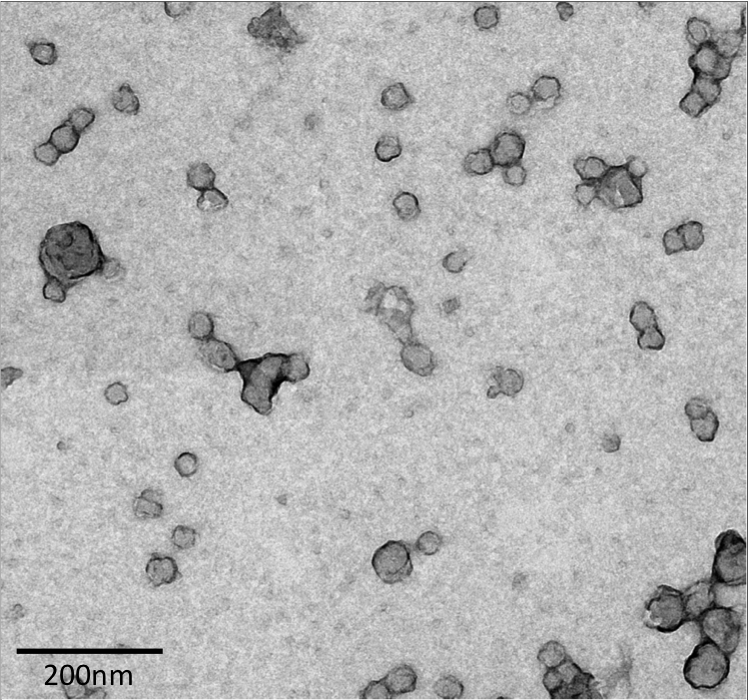The COVID-19 pandemic made mRNA a household term, but how much do people really know about these multifunctional molecules? Some people may also have heard of lipid nanoparticles (LNPs) which play a key role in protecting the mRNA and helping it get into the right cell making sure mRNA vaccines are safe and effective. But probably few non-scientists have heard of Extracellular Vesicles (EVs).
Before jumping into the world of EVs, perhaps a quick refresher on mRNA is in order: what is mRNA? Simply put, mRNA is a single-stranded RNA molecule that carries the information necessary for protein synthesis to occur. The human body is a giant factory that manufactures millions of proteins each day. These proteins play an essential role in regulating all of our bodily functions, including our immune system. The information provided by mRNA is an essential part of this synthesis.
While mRNA may be a necessary tool for the body, these molecules have an Achilles heel: they are extremely fragile and degrade quickly. When it comes to developing mRNA vaccines, this fragility is a real problem.
Enter LNPs. Made up of a layer of fats, LNPs are synthetically produced particles that act as a protective shell to prevent the mRNA from being broken down. The LNPs further help mRNA to deliver their cargo to the necessary cells in a form that will allow the efficient production of proteins. However, there remains much to learn about the exact mechanisms involved in the intracellular processing of LNPs, with the potential to improve the efficiency of mRNA delivery.
Nature’s version of LNPs
Now that we know our mRNA from our LNP, what about EVs? This is where things get interesting. It turns out, the body already makes particles similar to LNPs that carry a diverse array of biologically active cargo, including RNA, and play essential roles in intracellular communication. These cell-secreted nanoparticles are called extracellular vesicles (EVs).

When EVs were initially observed 50 years ago, researchers derisively termed them as nature’s ‘garbage bags,’ as they were believed to be involved only in removing waste products from cells. But the thinking has greatly evolved since then.
“In the last 30 years, we’ve realised that the cargo that these EVs hold isn’t just waste,” explains Professor Julia Burnier, a scientist in the Cancer Research Program at the Research Institute of the McGill University Health Centre (RI-MUHC). “What’s more interesting is that in the last few decades we’ve learned that EVs are actually cell-to-cell communicators. What they release is then internalised in a variety of ways by what we call recipient cells.”
Professor David Juncker, who is also interested in the properties of this class of particle, takes the metaphor further. “EVs are like the postal system of the body,” he says. “They carry information both locally and long distance.”
The two researchers recently signed agreements to have their new EV research projects funded by Moderna. The agreements are the outcome of a competitive process organized by the McGill Office of Innovation + Partnerships, through which 33 proposals were submitted for review. Moderna opted to move forward with these two investigations.
“This R&D investment demonstrates Moderna’s commitment to maximizing the potential of our mRNA technology to deliver innovative mRNA medicines to patients by collaborating with the best and brightest scientists from around the world,” explains Kate Jeffrey, Vice President Immune Therapeutics Discovery, Research and Early Development, Moderna.
You can’t miss what you can’t measure: LNPs

Measuring such small particles (otherwise known as ‘characterizing’) is Professor Juncker’s area of expertise. Not only are nanoparticles incredibly small – 100,000 times smaller than the thickness of a sheet of paper – they are also different sizes, the standard range is accepted to be from three to 18 nanometers across. This lack of uniformity means that while it is possible to get an average value of the amount of mRNA that was loaded into LNPs, it can be difficult to measure this for each single LNP.
“The better we know them, the better we can control them,” says Juncker, explaining the rationale behind the project. “This will allow us to make them smarter, and we can program them with multiple functions.”
Professor Juncker’s team believes that the method they are developing to characterize thousands of LNPs by quantifying their size and RNA content will help to define for manufacturing and research of mRNA products.
However, he is also well aware that measurements of LNPs can also be applied to EVs. “Currently, LNPs are like an envelope without an address, but our platform will eventually allow us to create parcels that both have the correct address and the correct content.”
To achieve this level of detail, Juncker’s team will rely on label-free interference scattering microscopy (iSCAT). ‘Label-free’ refers to the fact that the technique does not use dyes or other types of markers that are commonly used when trying to capture images of small particles. ‘Interference scattering’ refers to the propensity of any particle to scatter the light waves that are used to take the image, and that this scattered light can interfere with a reference light beam – thus enabling an accurate measurement to be taken.
Creating a synthetic EV library
While Professor Juncker’s work may be primarily focused on LNPs, the potential for its use to understand the properties of EVs is enormous. It also dovetails perfectly with Professor Burnier’s research. A molecular biologist by training, her interest lies in developing a greater understanding of how EVs behave, and what the implications are to other areas of health beyond preventing viral infections.
“From the perspective of being able to deliver things to specific sites and be taken up by specific cells, that is really valuable when we think about things like cancer vaccines.” says Burnier. “Naturally occurring EVs have shown specificity and enrichment to express proteins on their surface to evade immune cells and to promote internalising by specific cells. We can change their physical and molecular properties to modulate their biodistribution and uptake and that is very valuable in the delivery space.”
The project aims to create a library of LNP formulations based on EVs, which will help to determine the properties that make them optimized for uptake by specific human cells. This will help advance mRNA medicine as the delivery of mRNA cargo to target cells for efficient uptake is dependent on the quality of its delivery system.
“If we can modulate the characteristics and what sits on the surface of the LNPs so that they are optimized for uptake by specific cell types, then it means that the efficiency of delivery is increased and also the off-target effects are diminished,” she says.
Burnier points out that there are many types of EVs identified thus far, and they likely interact with target cells in different ways. In addition, a single EV can carry many different kinds of cargo – as many as 200 different proteins could be found in a single EV, which highlights the multi-functionality alluded to by Professor Juncker.
Both researchers will have access to the new Centre for Applied Nanomedicine (CAN) at the RI-MUHC, a specialized technology platform and research hub for studies on extracellular vesicles (EVs) and nanosized extracellular particles (EP). CAN houses a range of state-of-the-art instrumentation that includes particle counters, particle sizers and equipment enabling multidimensional single-vesicle analysis.
Building on longstanding ties
This is far from the first time McGill and Moderna have collaborated to break new ground in RNA-related science. In 2012, Moderna approached Nahum Sonenberg, an eminent McGill University professor and researcher, for his expertise in RNA biology and mRNA translation. Sonenberg along with Yuri Svitkine and other researchers from Moderna discovered a method that would allow modified mRNA to avoid activating the immune system. This modification would lead to better translation of the mRNA, a technique Moderna uses in its SARS-Cov2 vaccine (as summarized in this piece).
More recently, McGill was the first Canadian university to join Moderna’s mRNA Access program, which aims to accelerate the development of new vaccines and medicines for emerging and neglected infectious diseases. This new work in EVs and LNPs also promises to yield an even greater understanding of the molecular underpinning of life and the chance to further expand the boundaries of what is possible with mRNA vaccines and therapies.
"Our body already produces nanoparticles that are effective at delivering messages,” explains Burnier. “Why don't we turn back to nature and copy the characteristics, parameters, and compositions of these natural EVs that we know are an effective delivery system? That’s really our goal.”
